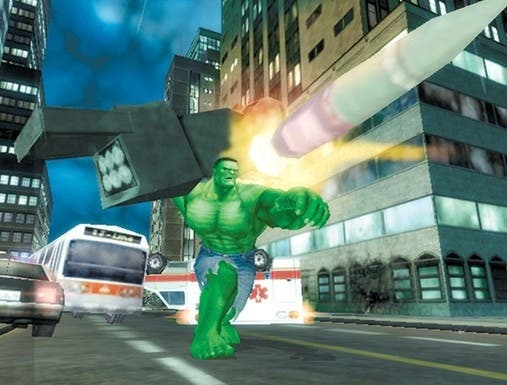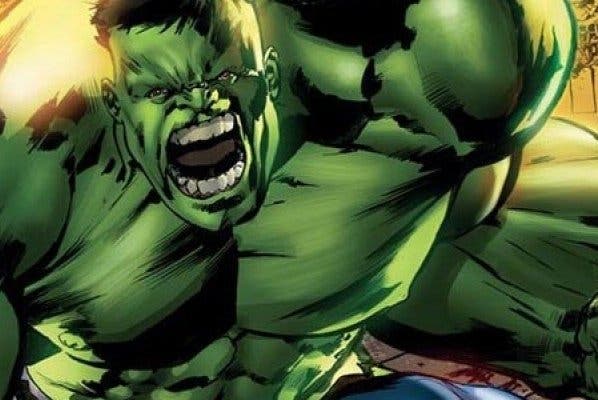The Incredible Hulk: Ultimate Destruction was super, smashing, great
The vast and the furious.
The first issue of The Incredible Hulk was published in May 1962, written by movie cameo addict Stan Lee and featuring spectacular art by the great Jack Kirby. The cover depicts a familiar-looking but grey behemoth looming over a skinny, scared guy in a lab coat. "Is he man or monster or... is he both?" asks the blurb, clearly in rather an existential tizzy. In the five decades since, the Hulk has survived various character evolutions and a series of hard reboots. But if we know anything about Marvel's brawl-y green giant, it's that the monster and the man co-exist, or at least time-share. An aggravated Hulk will kick the tar out of baddies all day long, but once his famous anger dissipates the big guy visibly deflates like a parade balloon with a slow puncture, returning to his other, slightly less imposing form: puny Bruce Banner.
The Incredible Hulk: Ultimate Destruction took this absolute cornerstone of the character and cheerfully binned it. Poor Bruce has no juice: in Radical Entertainment's 2005 game you are all Hulk, all the time. The classic Jekyll-and-Hyde squall of internal conflict is completely stripped away or, more accurately, repurposed as externalised conflict, the sort of conflict that video games do very well. Anger is an energy, and at its best, Ultimate Destruction lights up the screen with sensationalised, ring-a-ding pyrotechnics, like a pinball table plugged directly into the National Grid. It doesn't fetishise violence, but it certainly aestheticises it, spotlights it, rhapsodises it. It's a sandbox game in the truest sense, in that it presents you with an elaborate clump of sandcastles disguised to look like skyscrapers and puts you in control of the world's largest, greenest, tantrum-iest toddler, ready and eager to stamp all over them. Once you've earned enough Smash Points to start digging properly into Hulk's surprisingly large repertoire of unlockable abilities, Ultimate Destruction becomes a freestyler's heaven, like parkour for Godzilla.

Even for a game released a decade ago, Ultimate Destruction's open world can seem basic rather than bustling. The Badlands is a Death Valley-style desert of sandy canyons and towering mesas, a generally featureless map broken up by hardscrabble towns, isolated military bunkers and the occasional longhorn steer, moo-ing as you roar past. In the anonymous city, the processing emphasis is on how concrete, glass and tarmac will crumble, crack and explode as Hulk lurches around rather than recreating an absorbing clockwork simulacrum of modern urban living. There are a pockets of foot traffic, but presumably most of the civilians are using the city's extensive public transport network: it's very common to skid round a corner and be faced with an entire street bogged down with a traffic jam composed entirely of buses. At this point it's incredibly difficult to resist the temptation to slam down on the sprint button to see what happens when Hulk charts a path through them.
Though the model is clearly GTA, it would be impractical to commandeer a vehicle, but one button is reserved for unleashing an incoherent Hulk roar, your own version of a car horn. What Hulk can do is grab and then "weaponise" passing traffic, fashioning boxing gloves out of hatchbacks and panel-beating one of those numerous buses into a crudely flattened shield that can also, wonderfully, be pressed into service as a surfboard. The idea of Hulk using tools as well as his enormous fists and feet is explored in intriguing ways: the wrecking ball from a crane can literally become a ball and chain, like God of War's Blades of Chaos re-imagined as a giant mono-conker. Over in the Badlands, if you see an iconic pumpjack nodding away to bring oil to the surface, you can barge into it, scoop up its counter-weighted spar and essentially use it as an enormous hockey stick. Traversal comes in the form of gamma-boosted, chargeable jumps, and slamming into the side of buildings or canyons just means Hulk bounding up them vertically, leaving a breadcrumb trail of impacts in his wake. You feel powerful, and the ground shakes when you land. Isn't that why we play video games, to feel like the empowerment of all that strength?
It probably helps that Ultimate Destruction wasn't required to echo or expand an existing Hulk property, as it came sandwiched between the two official film tie-ins to date. The previous Hulk game, also developed by Radical, was based on Ang Lee's 2003 Hulk, now considered to be the Marvel Cinematic Universe's greatest false start. That game was praised for its striking visuals but also ripped apart by critics for having long dull stretches - so you could make a case for it being one of the most faithful movie adaptations ever made. (The Incredible Hulk: The Official Videogame, based on Louis Leterrier's bodged blockbuster, arrived in 2008, and while it wasn't developed by Radical, it did bring Ultimate Destruction's template of urban playground chaos to the then-current generation of consoles, even if its greatest innovation appeared to be an absurdly detailed player avatar who looked both unappealingly ripped and a little grey around the gills.)

That's not to say Ultimate Destruction's plot is a path-breaking masterpiece. Centred around The Abomination's lust for power of all kinds, it only really exists as a flowchart to steer you toward destroying things using a variety of different methods. There is a lot of business to do with protecting or destroying substations. To begin with, and extremely appropriately, Hulk can smash through everything and everyone in his path. But as your enemies grow smarter, and bigger, you have to adapt, strategise and improvise. That might not speak to the idea of the Hulk as a raging monster but seeing this terrifying creature do something smart like catching a missile and throwing it back at a jet is weirdly funny. And there is a sly intelligence at play. You can scoop up a (terrified) civilian, but if press one of the attack buttons, instead of pulverising them, you either replace them carefully on the ground and pat them on the head or bat them away with a dismissive, almost playful finger flick. (Attacking soldiers unfortunate to get lifted by Hulk get a more hefty backhand.)
But what happens when the dust settles, when The Abomination has been abdominally dominated by a series of devastating, charged-up bodyblows and a world-shaking atomic thunderclap? When Hulk wraps up, it leaves you with a deceptively quiet world, albeit one still patrolled by dangerous strike teams and dotted with one-off challenges. It's in this stomp-ready sandbox that you begin to see the seeds of Radical's next moves, where they applied their lessons from the Hulk and expanded the core gameplay ideas to create the Prototype franchise, where one man with a series of uncanny powers repeatedly sets a gigantic, detailed city on fire. Those games were recently remastered (rather disappointingly, by all accounts) for current-gen consoles, and were fun in their own, rather over-complicated, conspiracy sci-fi fashion. But even a decade on, Ultimate Destruction feels more than just a prototype Prototype. It's inventive, playful and the most satisfying and rewarding Hulk game to date.

